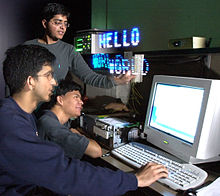ಹೆಲ್ಲೊ ವರ್ಲ್ಡ್ ಕಂಪ್ಯೂಟರ್ ಪ್ರೋಗ್ರ್ಯಾಮ್: ಪರಿಷ್ಕರಣೆಗಳ ನಡುವಿನ ವ್ಯತ್ಯಾಸ
ಚು →ಇತಿಹಾಸ |
|||
| ೯ ನೇ ಸಾಲು: | ೯ ನೇ ಸಾಲು: | ||
==ಇತಿಹಾಸ== |
==ಇತಿಹಾಸ== |
||
ಇಂಥ ಪರೀಕ್ಷಾ-ಪ್ರೋಗ್ರ್ಯಾಮುಗಳು ಮೊದಲೆ ಇದ್ದುವಾದರೂ "Hello, world!" ನುಡಿಗುಚ್ಛವನ್ನು ಬಳಸುವ ಪದ್ದತಿಗೆ ''The C Programming Language''<sup class="noprint Inline-Template Template-Fact" style="white-space: nowrap;" contenteditable="false">[<i>citation needed</i>]</sup>. ಎಂಬ ಪುಸ್ತಕದಲ್ಲಿನ ಉದಾಹರಣೆಯೊಂದು ಪ್ರೇರಣೆಯಾಯಿತು. . |
|||
While small test programs existed since the development of programmable [[ಗಣಕಯಂತ್ರ|computer]]s, the tradition of using the phrase "Hello, world!" as a test message was influenced by an example program in the seminal book ''The C Programming Language''<sup class="noprint Inline-Template Template-Fact" style="white-space: nowrap;" contenteditable="false">[<i>citation needed</i>]</sup>. The example program from that book prints "<code>hello, world</code>" (without capital letters or exclamation mark), and was inherited<sup class="noprint Inline-Template Template-Fact" style="white-space: nowrap;" contenteditable="false">[<i>citation needed</i>]</sup> from a 1974 Bell Laboratories internal memorandum by Brian Kernighan, ''Programming in C: A Tutorial'',<ref name="ctutorial">{{cite web| url = http://cm.bell-labs.com/cm/cs/who/dmr/ctut.pdf| title = Programming in C: A Tutorial}}</ref> which contains the first known version: |
|||
ಆ ಪುಸ್ತಕದಲ್ಲಿನ ಉದಾಹರಣೆಯು "<code>hello, world</code>" ಎಂದು ತೆರೆಯ ಮೇಲೆ ತೋರಿಸುತ್ತದೆ ,ಇದನ್ನು <sup class="noprint Inline-Template Template-Fact" style="white-space: nowrap;" contenteditable="false">[<i>citation needed</i>]</sup> ೧೯೭೪ ರ ಬೆಲ್ ಲ್ಯಾಬೊರೇಟರಿಯ ಬ್ರಯನ್ ಕೆರ್ನಿಘಾನ್ ರ ಆಂತರಿಕ ಮೆಮೊ - ''Programming in C: A Tutorial'',<ref name="ctutorial">{{cite web| url = http://cm.bell-labs.com/cm/cs/who/dmr/ctut.pdf| title = Programming in C: A Tutorial}}</ref> ದಿಂದ ತೆಗೆದುಕೊಳ್ಳಲಾಗಿದೆ. |
|||
==Variations== |
==Variations== |
||
There are many variations on the punctuation and casing of the phrase. Variations include the presence or absence of the comma and exclamation mark, and the capitalization of the 'H', both the 'H' and the 'W', or neither. Some languages are forced to implement different forms, such as "<code>HELLO WORLD!</code>", on systems that support only capital letters, while many "hello world" programs in esoteric languages print out a slightly modified string. For example, the first non-trivial Malbolge program printed "HEllO WORld", this having been determined to be good enough. |
There are many variations on the punctuation and casing of the phrase. Variations include the presence or absence of the comma and exclamation mark, and the capitalization of the 'H', both the 'H' and the 'W', or neither. Some languages are forced to implement different forms, such as "<code>HELLO WORLD!</code>", on systems that support only capital letters, while many "hello world" programs in esoteric languages print out a slightly modified string. For example, the first non-trivial Malbolge program printed "HEllO WORld", this having been determined to be good enough. |
||
೧೭:೨೯, ೩೦ ಮಾರ್ಚ್ ೨೦೧೫ ನಂತೆ ಪರಿಷ್ಕರಣೆ



ಒಂದು "'ಹೆಲ್ಲೊ ವರ್ಲ್ಡ್!" ಪ್ರೋಗ್ರ್ಯಾಮು' ( "Hello, World!" program )' ತೋರುತೆರೆಯೊಂದರ ಮೇಲೆ "Hello, World!" ( ಅಥವಾ ಅಂತಹ ಬೇರೆ ಸಂದೇಶ ) ಎಂದು ತೋರಿಸುವ ಒಂದು ಕಂಪ್ಯೂಟರ್ ಪ್ರೊಗ್ರ್ಯಾಮ್ ಆಗಿದೆ. . ಬಹಳಷ್ಟು ಪ್ರೋಗ್ರ್ಯಾಮಿಂಗ್ ಭಾಷೆಗಳಲ್ಲಿ ಸಾಧ್ಯವಿರುವ ಬಲುಸರಳವಾದ ಪ್ರೋಗ್ರ್ಯಾಂ ಆದ ಕಾರಣ ಅದನ್ನು ಪ್ರೋಗ್ರ್ಯಾಮಿಂಗ್ ಭಾಷೆಯೊಂದನ್ನು ಕಲಿಯಲು ಆರಂಭಿಸುವವರಿಗೆ ಆ ಭಾಷೆಯ ಮೂಲ ರಚನೆಯನ್ನು ತೋರಿಸಿಕೊಡಲು ಬಳಸಲಾಗುತ್ತಿದೆ. ಒಂದು ಭಾಷೆ ಅಥವಾ ಕಂಪ್ಯೂಟರ್ ನ ಕಾರ್ಯಕಾರಿ ವ್ಯವಸ್ಥೆಯು ವ್ಯವಸ್ಥೆ ಯು ಸರಿಯಾಗಿ ಕೆಲಸ ಮಾದುತ್ತಿರುವುದನ್ನು ಖಚಿತಪಡಿಸಿಕೊಳ್ಳಲೂ ಅದನ್ನು ಬಳಸಲಾಗುತ್ತದೆ.
ಉದ್ದೇಶ
"ಹೆಲ್ಲೊ ವರ್ಲ್ಡ್" ಪ್ರೋಗ್ರ್ಯಾಮು (ಕ್ರಮವಿಧಿ) ಸಾಮಾನ್ಯವಾಗಿ ಕಂಪ್ಯೂಟರ್ ಪ್ರೋಗ್ರ್ಯಾಮಿಂಗ್ ಕಲಿಯುವವರ ಪಾಲಿನ ಮೊದಲ ಪಾಠವಾಗಿದೆ . ಅದು ತುಂಬ ಸರಳವಾಗಿದ್ದು, ತಿಳಿದುಕೊಳ್ಳಲು ಬಲು ಸುಲಭವಾಗಿದೆ. ಇದನ್ನು ಆಧಾರವಾಗಿಟ್ಟುಕೊಂಡು ಒಂದು ಕಂಪ್ಯೂಟರ್ ಭಾಷೆಯಲ್ಲಿನ computer scienceದ ಮೂಲ ತತ್ವಗಳನ್ನು ಹೊಸಬರಿಗೆ ವಿವರಿಸಬಹುದಾಗಿದೆ. ನುರಿತ ಪ್ರೋಗ್ರ್ಯಾಮರ್ ಗಳು ಕೂಡ ಹೊಸಭಾಷೆಯೊಂದನ್ನು ಕಲಿಯುವಾಗ ಅದರ ನುಡಿಗಟ್ಟನ್ನೂ . ಭಾಷೆಯ ರಚನೆಯನ್ನೂ ಈ ಪ್ರೊಗ್ರ್ಯಾಮಿನಿಂದ ತಿಳಿಯಬಹುದಾಗಿದೆ.
ಅಷ್ಟೇ ಅಲ್ಲದೆ , ಒಂದು ಭಾಷೆಯ ಕಂಪೈಲರ್ , ಅಭಿವೃದ್ಧಿ-ಪೂರಕ-ಪರಿಕರ ( development environment) ಮತ್ತು ಇತರ ಪರಿಕರಗಳು ಕಂಪ್ಯ್ ಸರಿಯಾಗಿ ಅಳವಡಿಕೆಯಾಗಿವೆ ಎಂಬುದನ್ನು ಖಚಿತಪಡಿಸಿಕೊಳ್ಳಲು ಇದನ್ನು ಬಳಸಲಾಗುತ್ತದೆ.
ಇತಿಹಾಸ
ಇಂಥ ಪರೀಕ್ಷಾ-ಪ್ರೋಗ್ರ್ಯಾಮುಗಳು ಮೊದಲೆ ಇದ್ದುವಾದರೂ "Hello, world!" ನುಡಿಗುಚ್ಛವನ್ನು ಬಳಸುವ ಪದ್ದತಿಗೆ The C Programming Language[citation needed]. ಎಂಬ ಪುಸ್ತಕದಲ್ಲಿನ ಉದಾಹರಣೆಯೊಂದು ಪ್ರೇರಣೆಯಾಯಿತು. .
ಆ ಪುಸ್ತಕದಲ್ಲಿನ ಉದಾಹರಣೆಯು "hello, world" ಎಂದು ತೆರೆಯ ಮೇಲೆ ತೋರಿಸುತ್ತದೆ ,ಇದನ್ನು [citation needed] ೧೯೭೪ ರ ಬೆಲ್ ಲ್ಯಾಬೊರೇಟರಿಯ ಬ್ರಯನ್ ಕೆರ್ನಿಘಾನ್ ರ ಆಂತರಿಕ ಮೆಮೊ - Programming in C: A Tutorial,[೧] ದಿಂದ ತೆಗೆದುಕೊಳ್ಳಲಾಗಿದೆ.
Variations
There are many variations on the punctuation and casing of the phrase. Variations include the presence or absence of the comma and exclamation mark, and the capitalization of the 'H', both the 'H' and the 'W', or neither. Some languages are forced to implement different forms, such as "HELLO WORLD!", on systems that support only capital letters, while many "hello world" programs in esoteric languages print out a slightly modified string. For example, the first non-trivial Malbolge program printed "HEllO WORld", this having been determined to be good enough.
There are variations in spirit, as well. Functional programming languages, like Lisp, ML and Haskell, tend to substitute a factorial program for Hello World, as functional programming emphasizes recursive techniques, whereas the original examples emphasize I/O, which violates the spirit of pure functional programming by producing side effects.
The Debian and Ubuntu Linux distributions provide the "hello world" program through the apt packaging system; this allows users to simply type "apt-get install hello" for the program to be installed, along with any software dependencies. While of itself useless, it serves as a sanity check and a simple example to newcomers of how to install a package. It is significantly more useful for developers, however, as it provides an example of how to create a .deb package, either traditionally or using debhelper, and the version of hello used, GNU Hello, serves as an example of how to write a GNU program.
ಇವನ್ನೂ ನೋಡಿ
- List of Hello world program examples
- "99 Bottles Of Beer" as used in computer science
- Foobar
- Just another Perl hacker
- List of basic computer science topics
- Trabb Pardo-Knuth algorithm
ಉಲ್ಲೇಖಗಳು
- ↑ "Programming in C: A Tutorial" (PDF).
- Rösler, Wolfram. "Hello World Collection". helloworldcollection.de. — with 450+ programs, plus "Hello World" in 60+ human languages
- Hosey, Peter. "Hello World, cut four ways: How to write good (and bad) programs". boredzo.org.
- "Unsung Heroes of IT / Part One: Brian Kernighan". TheUnsungHeroesOfIT.com.
- "HelloData: A Simple ADO Application". MSDN. Microsoft.
